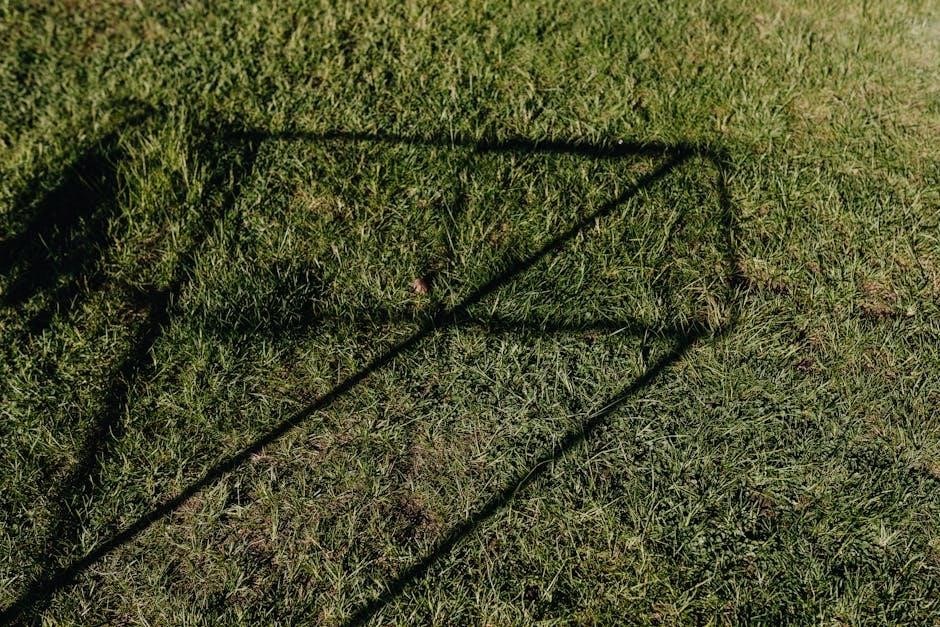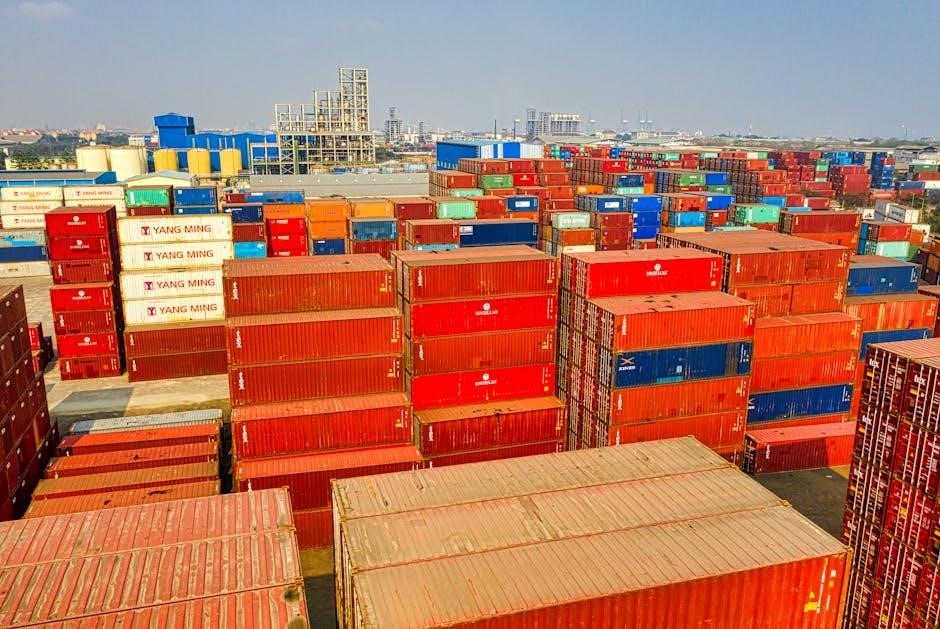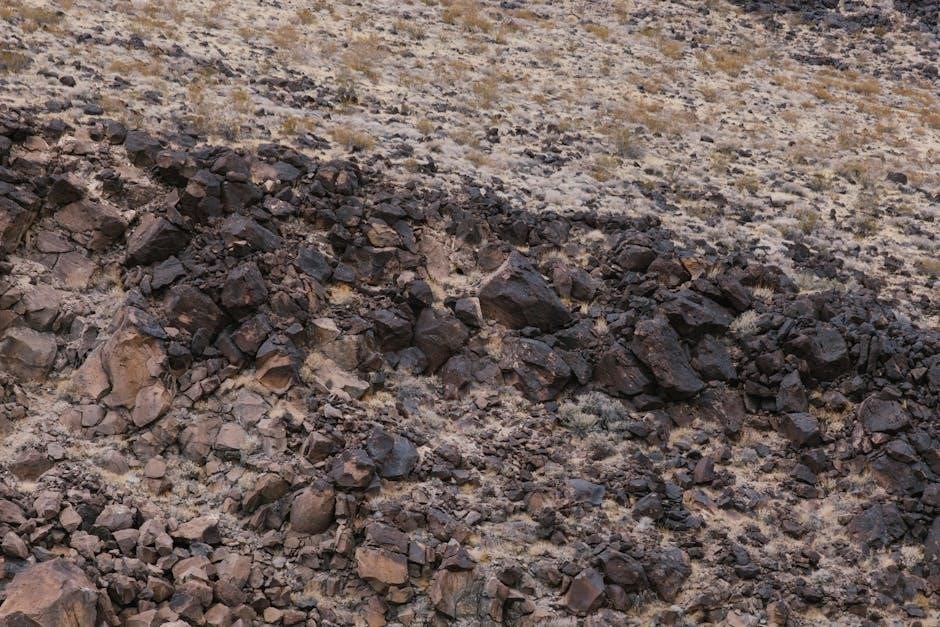Surface area and volume worksheets are essential tools for mastering 3D geometry. They provide interactive‚ visual exercises for calculating the surface area and volume of various shapes‚ such as prisms‚ cylinders‚ and cones. These resources often include answer keys‚ making them ideal for self-assessment and practice. Regular use of these worksheets helps students build problem-solving skills and a deeper understanding of spatial concepts.
1.1 Importance of Surface Area and Volume in Math Education
Mastering surface area and volume is crucial for understanding 3D geometry and spatial reasoning. These concepts are fundamental in STEM fields‚ enabling students to solve real-world problems‚ such as calculating materials for construction or liquid capacity. Regular practice with worksheets enhances problem-solving skills and mathematical confidence‚ making these topics essential for a strong math foundation.
1.2 Benefits of Using Worksheets with Answers in PDF Format
Worksheets with answers in PDF format offer convenience and accessibility. They provide clear exercises and solutions‚ enabling self-assessment and tracking of progress. PDFs are easy to download‚ print‚ and share‚ making them ideal for both classroom and home use. The inclusion of answers helps students verify their work‚ fostering independent learning and improved understanding of surface area and volume concepts.
Key Concepts of Surface Area and Volume
Surface area measures the total area of all faces of a 3D object‚ while volume calculates the space inside it. Both concepts are fundamental in geometry for understanding and solving problems involving 3D shapes.
2.1 Understanding Surface Area: Definition and Formula
Surface area is the total area covering all faces of a 3D object. For a rectangular prism‚ it’s calculated as 2(lw + lh + wh)‚ where l‚ w‚ h are length‚ width‚ and height. This formula sums the areas of all six faces‚ providing a comprehensive measure of the object’s exterior space.
2.2 Understanding Volume: Definition and Formula
Volume measures the space inside a 3D object‚ representing its capacity. For a rectangular prism‚ it’s calculated as length × width × height. The formula varies by shape; for example‚ a cylinder’s volume is πr²h‚ where r is the radius and h is the height. Accurate calculations require precise measurements and correct formula application.
2.3 Difference Between Surface Area and Volume
Surface area measures the total area covering a 3D object‚ while volume measures the space inside. Surface area involves adding the areas of all faces‚ whereas volume involves multiplying dimensions. They are both fundamental in geometry but serve distinct purposes‚ with surface area focusing on exterior and volume on interior space.
Types of Worksheets Available
Worksheets offer surface area and volume problems for rectangular prisms‚ cylinders‚ cones‚ spheres‚ and mixed shapes‚ catering to different grades and learning needs with answer keys included.
3.1 Worksheets for Rectangular Prisms
Worksheets for rectangular prisms focus on calculating surface area and volume‚ using formulas like (2(lw + lh + wh)) for surface area and (l imes w imes h) for volume. They include questions with varying dimensions‚ visual aids‚ and answer keys for self-assessment. These resources are ideal for grades 5-8‚ offering a structured way to master geometric calculations through consistent practice.
3.2 Worksheets for Cylinders‚ Cones‚ and Spheres
Worksheets for cylinders‚ cones‚ and spheres focus on applying specific surface area and volume formulas. For cylinders‚ students calculate (2πr(h + r)) for surface area and (πr²h) for volume. For cones and spheres‚ similar exercises are provided‚ with visual aids and answer keys to ensure accuracy. These resources are designed to help students master complex geometric calculations through structured practice.
3.3 Mixed 3D Shapes Revision Worksheets
Mixed 3D shapes revision worksheets combine exercises on prisms‚ cylinders‚ cones‚ and spheres. They help students apply surface area and volume formulas across different shapes‚ reinforcing their understanding. These worksheets often include visual aids and answer keys‚ allowing students to practice and self-assess their ability to calculate surface area (2πr(h + r)) and volume (πr²h) for various shapes‚ ensuring comprehensive mastery.

Where to Find Surface Area and Volume Worksheets
Surface area and volume worksheets are available on educational websites like K5 Learning‚ Math Goodies‚ and Kuta Software. They offer free PDF downloads for various grade levels‚ ensuring easy access to practice materials.
4.1 Educational Websites Offering Free PDF Downloads
Educational websites like K5 Learning‚ Math Goodies‚ and Kuta Software provide free PDF downloads of surface area and volume worksheets. These resources cover various shapes‚ such as prisms‚ cylinders‚ and cones‚ and cater to different grade levels. Many include answer keys‚ making them ideal for self-assessment and home study. They also often feature visual aids and step-by-step solutions to enhance learning.
4;2 Math Software and Platforms Providing Worksheets
Math software like Kuta Software and SMath Studio offer customizable worksheets for surface area and volume problems. These platforms provide tools to generate PDFs with answer keys‚ catering to various skill levels. They also include features for creating visual aids and step-by-step solutions‚ making them ideal for both teachers and students seeking interactive learning resources.
4.3 School and Teacher Resources for Custom Worksheets
Schools and educators often provide tailored worksheets for surface area and volume. Resources like Rush-Henrietta Central School District and Nottingham Free School offer PDFs with answers. Platforms like Kuta Software allow teachers to customize problems‚ ensuring worksheets align with curriculum needs and cater to varying student abilities‚ enhancing personalized learning experiences.

How to Use Worksheets Effectively
Start with basic problems‚ gradually increasing difficulty. Use answer keys for self-assessment and incorporate worksheets into regular study routines to reinforce concepts and improve problem-solving skills consistently.
5.1 Starting with Basic Problems and Gradually Increasing Difficulty
Begin with simple surface area and volume problems‚ such as cubes or rectangular prisms‚ to build foundational skills. Progress to complex shapes like cylinders or cones. Use answer keys to verify solutions and address gaps. Regular practice with increasing difficulty enhances problem-solving abilities and mastery of 3D geometry concepts effectively.
5.2 Using Answer Keys for Self-Assessment
Answer keys in surface area and volume worksheets allow students to verify their solutions independently. By comparing their work with provided answers‚ learners can identify errors‚ understand correct methods‚ and reinforce their understanding. This self-assessment tool is particularly useful for improving accuracy and confidence in solving geometric problems effectively.
5.3 Incorporating Worksheets into Regular Study Routines
Incorporating surface area and volume worksheets into daily or weekly study routines ensures consistent practice and mastery. By dedicating specific times for these exercises‚ students can build confidence and accuracy. Structured schedules help in gradual skill development‚ making complex concepts more manageable and engaging over time.

Common Mistakes to Avoid
Common mistakes include misapplying formulas‚ incorrect unit conversions‚ and neglecting to consider all faces or dimensions when calculating surface area and volume.
6.1 Misapplying Formulas for Surface Area and Volume
One common mistake is misapplying formulas‚ such as confusing surface area with volume or using incorrect dimensions. For example‚ using the radius instead of the diameter in a cylinder’s formula can lead to errors. Students often mix up the formulas for different shapes‚ like using a prism’s surface area formula for a sphere. Regular practice with correct formulas helps avoid these errors.
6.2 Incorrect Unit Conversions
Incorrect unit conversions are a frequent error‚ often leading to inaccurate surface area and volume calculations. For instance‚ mixing meters and centimeters without proper conversion can result in wrong answers. Always ensure all measurements are in consistent units before applying formulas. Neglecting this step can cause significant errors in both surface area and volume problems‚ emphasizing the need for careful attention to unit consistency.
6.3 Neglecting to Consider All Faces or Dimensions
Neglecting to consider all faces or dimensions is a common mistake when calculating surface area and volume. For surface area‚ missing even one face of a shape can lead to incorrect results. Similarly‚ for volume‚ omitting a dimension or miscalculating its contribution can significantly affect the outcome. Always double-check that all faces and dimensions are accounted for to ensure accuracy in calculations.
Interactive and Engaging Resources
Interactive resources enhance learning through online tools for 3D shape visualization‚ gamified platforms for practice‚ and video tutorials offering additional support and engagement for math concepts.
7.1 Online Tools for Visualizing 3D Shapes
Online tools allow students to visualize and interact with 3D shapes‚ enhancing their understanding of surface area and volume. These tools enable users to rotate‚ zoom‚ and explore geometric models‚ making complex concepts more accessible. Features like net generators and measurement calculators help students grasp spatial relationships and apply formulas effectively in problem-solving scenarios.
7.2 Gamified Platforms for Practicing Surface Area and Volume
Gamified platforms transform surface area and volume practice into engaging experiences. These tools use points‚ badges‚ and leaderboards to motivate students. Interactive exercises and puzzles make learning fun while reinforcing geometric concepts. Such platforms often include timed challenges and progress tracking‚ helping students stay focused and build confidence in their problem-solving abilities.
7.3 Video Tutorials and Webinars for Additional Support
Video tutorials and webinars provide interactive learning experiences‚ breaking down complex concepts into digestible parts. These resources often include step-by-step explanations‚ real-world examples‚ and visual demonstrations. They are particularly helpful for students needing extra support‚ offering flexibility to pause‚ rewind‚ and revisit lessons. Webinars also allow interaction with instructors‚ fostering a deeper understanding of surface area and volume calculations.

Differentiated Instruction with Worksheets
Differentiated instruction uses worksheets tailored to varied learning needs. Teachers adapt problems for grade levels‚ skill sets‚ and special needs‚ ensuring all students engage effectively with the material.
8.1 Adapting Worksheets for Different Grade Levels
Worksheets can be tailored to suit various grade levels‚ ensuring content aligns with students’ understanding. For younger grades‚ problems focus on basic formulas‚ while older students tackle complex shapes. Visual aids and simplified instructions help lower-grade learners‚ while high school worksheets introduce advanced concepts. This adaptability ensures a smooth progression in mastering surface area and volume calculations.
8.2 Customizing Problems for Varying Skill Levels
Worksheets can be customized to cater to students with varying skill levels. Basic problems focus on simple shapes and formulas‚ while advanced exercises incorporate complex 3D figures like cones and spheres. This differentiation ensures that both struggling and high-achieving students receive appropriate challenges‚ fostering progress and confidence in their understanding of surface area and volume concepts.
8.3 Using Worksheets for Special Needs Education
Surface area and volume worksheets can be adapted for special needs students by simplifying problems and incorporating visual aids. Step-by-step instructions and larger fonts enhance accessibility. Interactive elements‚ such as matching games‚ engage students with different learning styles. These tailored resources help build foundational math skills and confidence‚ ensuring inclusive education for all learners‚ regardless of ability level.
Real-World Applications of Surface Area and Volume
Surface area and volume concepts apply to engineering‚ architecture‚ and everyday problem-solving. They aid in designing packaging‚ calculating construction materials‚ and understanding scientific principles like pressure and fluid dynamics.
9.1 Engineering and Architecture
Engineers and architects use surface area and volume calculations to design structures‚ estimate materials‚ and optimize spaces. These concepts are crucial for ensuring structural integrity‚ material efficiency‚ and cost-effectiveness in construction projects. From building design to infrastructure development‚ understanding these principles is essential for creating safe and functional environments.
9.2 Science and Physics
Surface area and volume are fundamental in science and physics for understanding concepts like pressure‚ density‚ and material properties. Calculating surface area helps in determining forces acting on objects‚ while volume is crucial for measuring capacity and density. These principles are applied in real-world scenarios‚ such as engineering designs and scientific experiments‚ to solve complex problems accurately.
9.3 Everyday Problem-Solving Scenarios
Understanding surface area and volume is vital for everyday tasks‚ such as calculating paint needed for walls or determining storage capacities. Worksheets help students apply these concepts to real-life scenarios‚ like measuring water in containers or estimating material costs for projects. These skills enhance problem-solving abilities in practical situations‚ making math relevant and useful in daily life.
Consistent practice with surface area and volume worksheets is key to mastering these concepts. Regular use enhances problem-solving skills and applies to real-world scenarios‚ fostering mathematical confidence and practical application abilities.
10.1 Summary of Key Points
Surface area and volume worksheets with answers in PDF format are invaluable for practicing geometric calculations. They cover various shapes‚ such as prisms‚ cylinders‚ and cones‚ and provide clear solutions for self-assessment. Regular practice with these resources enhances understanding‚ improves problem-solving skills‚ and prepares students for real-world applications in fields like engineering and architecture. They are accessible‚ free‚ and designed for all skill levels.
10.2 Encouragement for Regular Practice
Consistent practice with surface area and volume worksheets is crucial for mastering 3D geometry. Regular exercises improve understanding‚ enhance problem-solving skills‚ and build confidence. These worksheets‚ available in PDF formats‚ offer a structured approach to learning‚ ensuring readiness for advanced math concepts and real-world applications. Make them a part of your daily study routine for steady progress.
